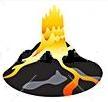
VOLCANO
ABOUT VOLCANO
A volcano is an opening, or rupture, in a planet's surface or crust, which allows hot magma, volcanic ash and gases to escape from below the surface.Volcanoes are generally found where tectonic plates are diverging or converging.
WHAT TO DO BEFORE
Here are some emergency safety guidelines that could help you prepare for a volcanic eruption.
- If your home is located within the few kilometers from the volcano, evacuate at once. You can opt to take your belongings with you or just leave them.
- Earthquakes are normal occurrences when an active volcano is about to erupt so do not panic. Instead, proceed to doing the precautionary measures.
- Sudden rains especially at the crater of the volcano would lead to an abrupt mudflow. The mud is not ordinary mud. It can contain pre-volcanic eruption debris and could be too hot that is enough to hard-boil an egg. Beware, or you may suffer from burns coming from mudflow.
- When the volcano finally erupts, it may emit volcanic debris up in the air. Be prepared to see falling rocks and small stones coming from the crater. Thus, take a safe shelter during the eruption.
- Prepare gas masks because the volcanic eruption may also be accompanied by foul odor coming from the release of sulfur. You may suffocate or may not be able to take normal breathing during a volcanic eruption.
- Lava is the centerpiece of the eruption. It is also the most destructive material the volcano will produce during an eruption. It is composed of very hot mud that may instantly burn down any material. Avoid contact with the lava.
After the eruption, wait for volcanologists' advice on when you can safely get back to your homes.
WHAT TO DO DURING
- Listen to a battery-powered radio or television for the latest emergency information.
- If you have a respiratory ailment, avoid contact with any amount of ash.
- Wear long-sleeved shirts and long pants.
- Use goggles and wear eyeglasses instead of contact lenses.
- Use a dust mask or hold a damp cloth over your face to help with breathing.
- Stay away from areas downwind from the volcano to avoid volcanic ash.
- Stay indoors until the ash has settled unless there is a danger of the roof collapsing.
- Close doors, windows, and all ventilation in the house (chimney vents, furnaces, air conditioners, fans, and other vents.
- Clear heavy ash from flat or low-pitched roofs and rain gutters.
- Avoid running car or truck engines. Driving can stir up volcanic ash that can clog engines, damage moving parts, and stall vehicles.
- Avoid driving in heavy ash fall unless absolutely required. If you have to drive, keep speed down to 35 MPH or slower.
WHAT TO DO AFTER
- Pay attention to warnings, and obey instructions from local authorities. For example, stay indoors until local health officials tell you it is safe to go outside.
- Stay away from ashfall areas, if possible. Avoid contact with ash as much as you can. Keep your skin covered to avoid irritation from contact with ash.
- Wear goggles to protect your eyes from ash.
- Do not travel unless you have to. Driving in ash is hazardous to your health and your car. Driving will stir up more ash that can clog engines and stall vehicles.
- Replace disposable furnace filters or clean permanent furnace filters frequently.
- If your drinking water has ash in it, use another source of drinking water, such as purchased
bottled water, until your water can be tested.



